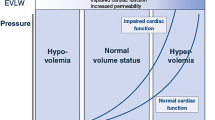Summary
The assessment of the impaired sympathetic-vagal balance provides in many disorders unique information concerning prognosis and treatment strategies. Especially the indications for using the heart rate variability analysis and the baroreflex sensitivity evaluation are well defined and proven in large prospective studies. The ventilatory and cardiac chemoreflex sensitivities are tools which could improve prediction of malignant cardiac arrhythmias and the prognosis of patients with advanced chronic heart failure. They are at this stage in the focus of intense research. Especially sepsis and MODS, as ICU-relevant disorders, are coupled with an impairment of autonomic function. Thus, the reduction of heart rate variability in such patients culminated in the loss of the nerval-humoral organ interaction (“uncoupling of biological oscillators”) hypothesis. This idea nowadays contributes to the pathophysiological concept of the clinical manifestations of sepsis and MODS.
Zusammenfassung
Die Analyse der sympathisch-vagalen Balance vermittelt bei vielen Krankheitsbildern wertvolle Informationen hinsichtlich Prognose und Behandlungsstrategien. Zur Erfassung dieses Parameters bei Intensivpatienten dienen vor allem die Analyse der Herzfrequenzvariabilität und der Baroreflexsensitivität, die wohldefiniert und in großen prospektiven Studien erprobt sind. Die ventilatorischen und kardialen Chemoreflexsensitivitäten dagegen als potentielle Prädiktoren maligner kardialer Arrhythmien und der Prognose bei chronischer Herzinsuffizienz sind zur Zeit Gegenstand intensiver Forschungsaktivitäten. Ziel ist es, die Aussagekraft bei diesen Krankheitsbildern zu validieren. Auch Sepsis und MODS als besonders für die Intensivmedizin relevante Erkrankungen sind mit einer Beeinträchtigung der autonomen Funktion, gemessen als Reduktion der Herzfrequenzvariabilität, verbunden. Die Einschränkung der Herzfrequenzvariabilität bei solchen Patienten ist ein Hinweis auf den Verlust der neuro-humoralen Organinteraktion („Uncoupling of biological oscillators“). Diese Idee scheint im pathophysiologischen Konzept der Sepsis und des MODS zunehmend an Attraktivität zu gewinnen.
Similar content being viewed by others
Author information
Authors and Affiliations
Additional information
Eingegangen: 10. September 1999/Akzeptiert: 6. Oktober 1999
Rights and permissions
About this article
Cite this article
Schmidt, H., Heinroth, K., Müller-Werdan, U. et al. Die autonome Dysfunktion des Intensivpatienten – ein Überblick. Intensivmed 37, 7–18 (2000). https://doi.org/10.1007/s003900050003
Issue Date:
DOI: https://doi.org/10.1007/s003900050003




